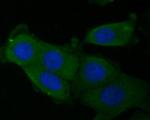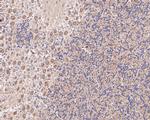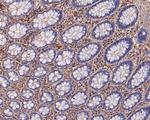Search Thermo Fisher Scientific
Invitrogen
eIF3b Recombinant Rabbit Monoclonal Antibody (JE54-00)
FIGURE: 1 / 9
eIF3b Antibody (MA5-36159) in ICC/IF









Product Details
MA5-36159
Species Reactivity
Published species
Host/Isotype
Expression System
Class
Type
Clone
Immunogen
Conjugate
Form
Concentration
Purification
Storage buffer
Contains
Storage conditions
Shipping conditions
RRID
Target Information
RNA-binding component of the eukaryotic translation initiation factor 3 (eIF-3) complex, which is required for several steps in the initiation of protein synthesis (PubMed:9388245, PubMed:17581632, PubMed:25849773, PubMed:27462815). The eIF-3 complex associates with the 40S ribosome and facilitates the recruitment of eIF-1, eIF-1A, eIF-2:GTP:methionyl-tRNAi and eIF-5 to form the 43S pre-initiation complex (43S PIC). The eIF-3 complex stimulates mRNA recruitment to the 43S PIC and scanning of the mRNA for AUG recognition. The eIF-3 complex is also required for disassembly and recycling of post-termination ribosomal complexes and subsequently prevents premature joining of the 40S and 60S ribosomal subunits prior to initiation (PubMed:9388245, PubMed:17581632). The eIF-3 complex specifically targets and initiates translation of a subset of mRNAs involved in cell proliferation, including cell cycling, differentiation and apoptosis, and uses different modes of RNA stem-loop binding to exert either translational activation or repression (PubMed:25849773). [UniProt]
For Research Use Only. Not for use in diagnostic procedures. Not for resale without express authorization.
Bioinformatics
Protein Aliases: eIF-3-eta; eIF-3-eta {ECO:0000255|HAMAP-Rule:MF_03001}; eIF3 p110; eIF3 p116; EIF3B; eIF3b {ECO:0000255|HAMAP-Rule:MF_03001}; Eukaryotic translation initiation factor 3 subunit 9; eukaryotic translation initiation factor 3 subunit 9 {ECO:0000255|HAMAP-Rule:MF_03001}; Eukaryotic translation initiation factor 3 subunit B; eukaryotic translation initiation factor 3 subunit B {ECO:0000255|HAMAP-Rule:MF_03001}; eukaryotic translation initiation factor 3, subunit 9 (eta); eukaryotic translation initiation factor 3, subunit 9 (eta, 116kD); eukaryotic translation initiation factor 3, subunit 9 eta, 116kDa; eukaryotic translation initiation factor 3, subunit B; hPrt1; MGC104664; MGC131875; Prt1 homolog
Gene Aliases: AL033316; AL033334; AL033369; AW208965; D5Wsu45e; EIF3-ETA; EIF3-P110; EIF3-P116; EIF3B; EIF3S9; PRT1
UniProt ID: (Human) P55884, (Mouse) Q8JZQ9, (Rat) Q4G061
Entrez Gene ID: (Human) 8662, (Mouse) 27979, (Rat) 288516

Performance Guarantee
If an Invitrogen™ antibody doesn't perform as described on our website or datasheet,we'll replace the product at no cost to you, or provide you with a credit for a future purchase.*
Learn more
We're here to help
Get expert recommendations for common problems or connect directly with an on staff expert for technical assistance related to applications, equipment and general product use.
Contact tech support
